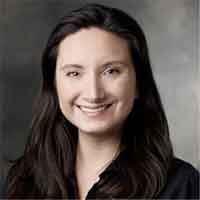Day in the Life of a Pulmonology Nurse Practitioner (NP)
Find NP Schools
For the 2023-2024 academic year, we have 140 NP schools in our database and those that advertise with us are labeled “sponsor”. When you click on a sponsoring school or program, or fill out a form to request information from a sponsoring school, we may earn a commission. View our advertising disclosure for more details.
“Pulmonology encompasses so many different things. You can subspecialize in the tiniest nuance of a disease, or you can cover the entire breadth of the specialty.”
Rachel Adney, Pediatric Nurse Practitioner, Division of Pediatric Pulmonology at Stanford Medicine Children’s Health
The role of the nurse practitioner (NP) has undergone many changes since its inception in 1965. As their education and training options have expanded and intensified, so have their duties and capabilities. The first NP programs focused on family care and disease prevention; today, NPs can specialize in as many areas as physicians can, pairing deep didactic knowledge with rigorous clinical experiences and a holistic, patient-centered nursing approach.
Pulmonology NPs specialize in issues related to the respiratory system. Those issues can include asthma, chronic obstructive pulmonary disease (COPD), lung cancer, and sleep apnea. They can work in both inpatient and outpatient settings, treating both acute and chronic conditions. They may subspecialize in a particular patient population (pediatrics or geriatrics) or in a particular pulmonologic condition. And, like most specialties, there’s much more to it than meets the eye.
October is Healthy Lung Month—the perfect time to learn more about this growing NP specialization. Read on to explore the life and work of pulmonology NPs, and how their role is changing over time.
Meet the Expert: Rachel Adney RN, MSN, PNP, AE-C

Rachel Adney is a pediatric nurse practitioner in the Division of Pediatric Pulmonology at Stanford Medicine Children’s Health. She received her MSN from Vanderbilt University School of Nursing in 2001, and completed her pediatric pulmonary nurse practitioner fellowship in 2013.
Adney developed significant asthma in her twenties, and chose to specialize in pediatric pulmonology to combine her experience in general pediatrics with her personal experience in helping patients.
A Typical Day for a Pulmonology NP
“Pulmonology encompasses so many different things,” Adney says. “You can subspecialize in the tiniest nuance of a disease, or you can cover the entire breadth of the specialty.”
Adney works as a pediatric pulmonology NP in an outpatient setting. She cares for children of all ages, from micro-preemies born at 23 to 28 weeks all the way to young adults at 21 years of age. Adney specializes in treating asthma and bronchopulmonary dysplasia (BPD), but she cares for patients with all types of pulmonary disease.
“When we get referrals sent to us, it’s kind of like solving a puzzle,” Adney says. “I like figuring out the pieces and how they fit together or don’t fit together.”
The puzzles are rarely simple, however, and there’s often more than one answer: a symptom as innocuous as a cough can mean a wide range of different things, and the reasons for it can be multifactorial. Adney will talk to her patients, listen to their stories, perform her examinations, collaborate with colleagues, and order X-rays and lab tests—all to construct a larger picture and reverse engineer the origin of those otherwise innocuous symptoms.
“Afterwards, I’ll meet with the patient, and help them understand their diagnosis,” Adney says. “And our patients typically do really well after that. There’s a lot we can do to help them have a normal life with full capacity and rich experiences.”
Despite working in a specialty office, Adney enjoys a fair amount of continuity. There are some patients she only sees once: after her assessment and diagnosis, they’ll be sent back to their primary care provider with a treatment plan. But Adney does continue to collaborate with primary care teams and patient families over longer periods of time. In her 12 years as a pulmonology NP at Stanford, she’s followed some patients for eight and nine years.
“A lot of our patients are underserved, and don’t have robust primary care clinics,” Adney says. “They bounce from provider to provider, either getting fit in or deferred because of a clinic’s schedule. In some of those cases, we end up acting as a patient’s primary care provider—especially for BPD babies, because they’re pretty complex.”
Adney is based in California, which is listed by the American Association of Nurse Practitioners (AANP) as a restricted practice state. However, she still enjoys a significant amount of autonomy, estimating that she works independently during approximately 90 percent of her clinical hours. Her time is split between a few different clinics, which allows her to connect with different types of patients than if she simply stayed in the Stanford area. But independent practice doesn’t mean a lack of collaboration and coordination with other medical professionals.
“On our team, we have medical doctors (MDs), physician assistants (PAs), resident nurses (RNs), medical assistants, (MAs), respiratory therapists (RTs), and other NPs,” Adney says. “We also have a social worker and a registered dietician. It’s an amazing support team, both for me and for our patients.”
The Evolution of the Pulmonology NP Role
Pulmonology is still a relatively small specialty area for NPs, but it is a rapidly evolving one. Over the last ten years, pulmonology, like other specialty practice areas, has seen a rise in the number of fellowships specifically targeted at NPs. In many cases, these fellowship programs mirror those of physician residents and are intended to facilitate the transition from education to practice. But they are also important for the maturation of the NP role as a whole, demonstrating the complex, comprehensive, and high-quality care that specialty NPs can provide.
In 2012, a year into her pediatric pulmonology NP career, Adney still occasionally received questions from other medical professionals about the scope of her specialty practice. Why was she seeing a patient if they didn’t have asthma? Adney and her mentor went on to coordinate with the University of Arizona Pediatric Pulmonary Center to create an entire pediatric pulmonology fellowship—one that was modeled after an MD’s pulmonary fellowship. The fellowship included 1,000 hours of clinical and didactic work split across several different subspecialty areas within pediatric pulmonology.
“By the end of that fellowship, I felt I had become an expert,” Adney says. “I had the breadth and depth of knowledge to be seen as more than just a practitioner who only sees patients with asthma. And we proved to my colleagues that I’d been through enough rigorous training and intense activity to be part of the team.”
Back in 2012, many NPs working in specialties and especially in subspecialties had to rely on generous mentors, on-the-job training, and their own adaptability in order to transition from NP school to real-world practice. For certain work settings that had a structure in place to assist new NPs, that was enough. But in other settings, it led to increased burnout, turnover, and all the other consequences of inadequate training.
In the last ten years, the number of fellowships has grown rapidly, and the fellowship model itself is a guiding indicator for where the specialty NP role is headed in the future: one with systemized specialty training, rigorous subspecialty exposure, and seamlessly integrated within the interprofessional care team.
“When you come out of nursing school, you don’t know anything about specialty practice areas except the basics,” Adney says. “But fellowships can truly make you an expert. I think fellowships have played a huge role already, and they’re going to be even more important in the future.”
Advocacy Issues for Pulmonology NPs
Most of a pulmonology NP’s advocacy is focused on advocating for patients, and that sort of patient advocacy operates on a few different levels.
Generally speaking, patient advocacy involves considering the whole patient: their cultural considerations, their family life, their social situation, and how all that intersects with their health. It also means connecting patients and their families to community resources, especially in underserved populations. And patient advocacy can also be linked to professional development in subtle ways that have an enormous impact: for Adney, it was brushing up on her Spanish.
“I took four years of Spanish in high school and two years in college, and knew nothing,” Adney laughs. “But now, depending on which clinic I’m working at, half my day or more can be in Spanish. It makes a big difference! There are some patients who, once they know you speak Spanish, feel comfortable with you and want to stay with you.”
Like all NPs, pulmonology NPs are also continuing to advocate for the recognition of their profession. That manifests itself primarily in the push for more modern legislation that matches the robust training NPs now receive. Because even though NPs like Adney are able to practice largely independently, they still encounter barriers to practice that are a result of esoteric requirements, and those barriers can hinder an NP’s ability to provide streamlined care.
“It can be a little cumbersome when it comes to equipment,” Adney says. “The only times I need a physician to sign something is when I need a patient to have a nebulizer machine or a pulse oximeter. And it’s not predictable, either: sometimes it depends on the insurance company, sometimes it depends on the pharmacy. Specifically in pulmonary care, it would be nice if we could move forward on this.”
Part of the professional advocacy for pulmonology NPs is also drawing attention to the rapid evolution of pulmonology as a specialty practice area, both through its increasing professionalization and its growing number of fellowships. And NPs like Adney are hopeful that more NPs will decide to specialize in pulmonology in the future, and help to grow the specialty further.
“It’s a really fun specialty,” Adney says. “We get to do a lot of primary care. We get to know patients and their families. And it’s connected to so many other issues, like exercise, nutrition, GI, and mental health. It’s complex, but you don’t have to face constant life-threatening situations. The majority of the time, we can help our patients, and they do better. It’s kind of the best of both worlds.”
Resources for Pulmonology NPs
To learn more about the work, advocacy, and research of pulmonology NPs, check out some of the resources below.
- American Association of Nurse Practitioners (AANP): With over 118,000 members, AANP is the largest organization for nurse practitioners, and they play a crucial role in advocating for NPs and their patients across the nation. Pulmonology NPs can find more about their practice area here.
- American Lung Association (ALA): For more than 115 years, the ALA has been a champion of lung health, envisioning a world free from lung disease. Their work involves education, advocacy, and research that reaches more than 20 million Americans every year.
- Association of Pulmonary Advanced Practice Providers (APAPP): The first professional association focused solely on NPs and PAs working in pulmonary medicine, APAPP advocates for rigorous standards of education and training, and promotes the expansion of fellowship and certification options for NPs and PAs practicing pulmonary care.

Matt Zbrog
WriterMatt Zbrog is a writer and researcher from Southern California, and he believes nurse practitioners (NP) are an indispensable component of America’s current and future healthcare workforce. Since 2018, he’s written extensively about the work and advocacy of NPs, with a particular focus on the rapid growth of specialization programs, residencies, fellowships, and professional organizations. As part of an ongoing series on state practice authority, he’s worked with NP leaders, educators, and advocates from across the country to elevate policy discussions that empower NPs. His articles have featured interviews with the leadership of the American Association of Nurse Practitioners (AANP), the National Association of Pediatric Nurse Practitioners (NAPNAP), and many other professional nursing associations.